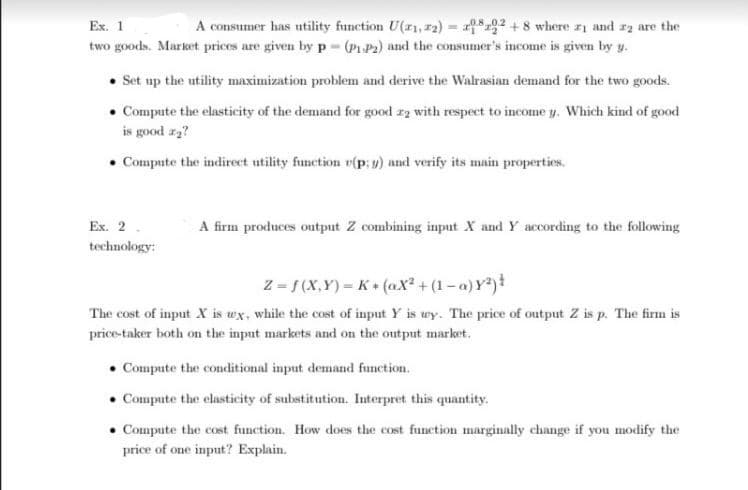A consumer has utility function U(21, 2) =4 +8 where z and zz are the two goods. Market prices are given by p (PL.P2) and the consumer's income is given by y. Ex. 1 • Set up the utility maximization problem and derive the Walrasian demand for the two goods. • Compute the elasticity of the demand for good z2 with respect to income y. Which kind of good is good z2? Compute the indirect utility function v(p; y) and verify its main properties.
A consumer has utility function U(21, 2) =4 +8 where z and zz are the two goods. Market prices are given by p (PL.P2) and the consumer's income is given by y. Ex. 1 • Set up the utility maximization problem and derive the Walrasian demand for the two goods. • Compute the elasticity of the demand for good z2 with respect to income y. Which kind of good is good z2? Compute the indirect utility function v(p; y) and verify its main properties.
Chapter5: Income And Substitution Effects
Section: Chapter Questions
Problem 5.12P
Related questions
Question

Transcribed Image Text:Ex. 1
two goods. Market prices are given by p (PL.P2) and the consumer's income is given by y.
A consumer has utility function U(11, 12) = 1*2 + 8 where zį and r2 are the
Set up the utility maximization problem and derive the Walrasian demand for the two goods.
• Compute the elasticity of the demand for good r2 with respect to income y. Which kind of good
is good z2?
Compute the indirect utility function v(P: ) and verify its main properties.
Ex. 2
A firm produces output Z combining input X and Y according to the following
technology:
Z = f (X,Y) = K (aX² + (1-a) Y)
The cost of input X is wx, while the cost of input Y is wy. The price of output Z is p. The firm is
price-taker both on the input markets and on the output market.
Compute the conditional input demand function.
Compute the elasticity of substitution. Interpret this quantity.
• Compute the cost function. How does the cost function marginally change if you modify the
price of one input? Explain.
Expert Solution
This question has been solved!
Explore an expertly crafted, step-by-step solution for a thorough understanding of key concepts.
Step by step
Solved in 3 steps

Recommended textbooks for you







Microeconomics: Private and Public Choice (MindTa…
Economics
ISBN:
9781305506893
Author:
James D. Gwartney, Richard L. Stroup, Russell S. Sobel, David A. Macpherson
Publisher:
Cengage Learning

Economics: Private and Public Choice (MindTap Cou…
Economics
ISBN:
9781305506725
Author:
James D. Gwartney, Richard L. Stroup, Russell S. Sobel, David A. Macpherson
Publisher:
Cengage Learning
